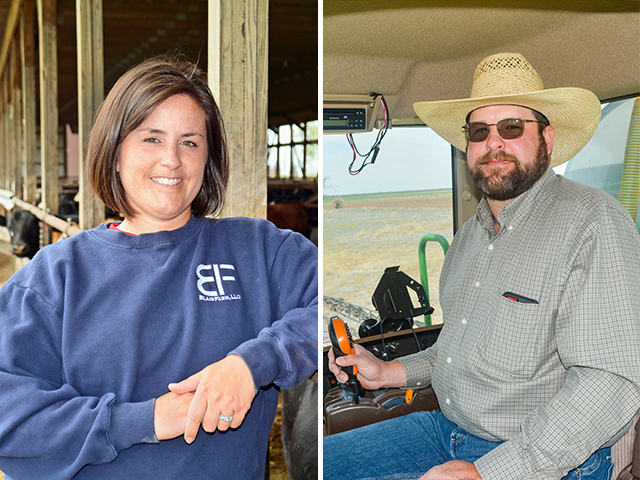Croplink
A View From Two Farms
Kellie Blair and Ryan Wieck live 900 miles apart, but the two farmers share plenty of common ground. This growing season, the Iowa and Texas farmers will be telling their stories through our "View From the Cab" feature. Meet them here and follow the weekly segments at www.dtnpf.com.
Kellie Blair, Dayton, Iowa:
Wearing many hats is part of a day's work on the diversified grain and livestock farm Kellie Blair manages with her husband, AJ, near Dayton, Iowa.
The Blairs grow corn, soybeans, alfalfa hay and small grains. Livestock operations include custom-fed pigs, cow/calf pairs and a beef feedlot. This year, they started a direct-beef sales business. Add two children, Wyatt and Charlotte, and there are few idle moments.
The fourth generation to operate this Century Farm, cover crops, cattle and conservation team up to keep the rich Webster County soils protected and producing year-round.
P[L1] D[0x0] M[300x250] OOP[F] ADUNIT[] T[]
Silage harvest allows earlier cover-crop seeding. In the fall, cows graze on cornstalks and rotational-graze cover crops. Come spring, no-till soybeans are planted into the cereal rye regrowth. Crop rotations include alfalfa hay and small grains such as oats, which are sold for milk and the straw baled. Some corn acres are being converted from strip-till to no-till.
Blair Farm uses a monoslope fat-cattle finishing barn. A surrounded concrete pad holds manure and contains potential runoff. Manure-nutrient-composition tests and regular soil tests guide fertilizer applications.
In 2013, a cow/calf component was added to bring more of their own calves into the feedlot. "The value in letting the consumer see everything about the calf from the time it was born is pretty exciting," Blair says.
Ryan Wieck, Umbarger, Texas:
Ryan Wieck's farming roots run deep. The 39-year-old farmer and his family -- wife, Cathy, and daughters, Callie and Charleigh, live on the Texas Panhandle homestead where his great-grandparents settled in 1920 between Umbarger and Dawn.
It is a region accustomed to weather extremes. The farm has not had more than 1 inch of rain at one time since September 2019.
In 2001, Wieck had the opportunity to lease a section of land and swapped labor for the use of his father's machinery. He used a custom hay-baling enterprise to help finance equipment purchases and grow his personal farm operation to include leased and owned land. Father and son still work together and have separate enterprises. The farm is split into a one-third layout (fallow), one-third summer-crop and one-third winter-crop rotation.
"I run a few mama cows and some cattle on wheat, weather permitting. I grow a couple fields of irrigated corn and irrigated cotton. I also grow dryland cotton and dryland wheat. Every now and then, we will grow some sorghum and some haygrazer (sorghum-sudan grass)," he says.
In the midst of a prolonged drought, Wieck marvels at the resilience of his ancestors who experienced the Dust Bowl years. "My Granddad always said the Texas Panhandle can promise so much and give so little, or can promise nothing and give you so much," he says.
**
-- Follow the latest from Pamela Smith, Crops Technology Editor, by visiting the Production Blogs at dtnpf.com or following her on Twitter @PamSmithDTN.
[PF_0621]
(c) Copyright 2021 DTN, LLC. All rights reserved.



